Widgetized Section
Go to Admin » Appearance » Widgets » and move Gabfire Widget: Social into that MastheadOverlay zone
Reviewing the Ruger Gunsite Scout 5.56
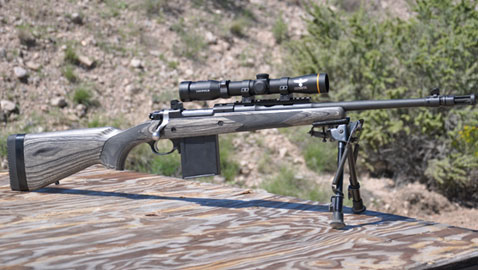
It started with a lightweight, short-barreled .308 Winchester rifle called the Frontier. Ruger’s Ken Jorgensen dropped it off at Gunsite and asked me to give it a try. Stocked in an attractive wood laminate cradling Ruger’s excellent M77 action, the little rifle was a shooter. It lived in my office and was loaned out to students and staff for about a year before I finally figured it out: Why can’t we turn this into a modern Scout rifle through a Gunsite/Ruger partnership? And that’s the question I asked Gunsite’s owner Buz Mills, gun writer and trainer Dave Spaulding, shooting television guru Michael Bane and Ken Jorgensen during a meeting at Gunsite. Ken took our input back to Ruger and in a matter of months he and engineer Mark Gurney were back at Gunsite with a couple of prototypes. The rest, as they say, is history and the Ruger Gunsite Scout Rifle (GSR) remains one of Ruger’s best selling rifles.
What’s a Scout Rifle, and how does it differ from traditional rifles? Good question. Promoted by Gunsite’s founder Jeff Cooper, his Scout concept was a theoretical exercise in how to create a handy, user-friendly general-purpose rifle suitable for hunting, sport and defense. Why did I say it was a theoretical exercise? Because, when Jeff envisioned the concept most of the components to arrange such a rifle simply didn’t exist. Fortunately, those days are long past and Ruger was able to take advantage of modern technology and manufacturing methods in producing the GSR – a rifle designed to be an accurate, affordable, compact, versatile, modern general-purpose rifle based upon Gunsite’s criteria.
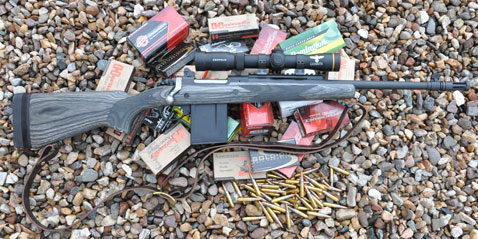
The GSR is available in blued and stainless steel models as well as left and right-handed versions. Initially made in .308 Winchester it is now available in 5.56 NATO, the two most popular and universally available centerfire rifle cartridges. The specifications for each of these versions of the GSR are available on Ruger’s website so I won’t take your time citing them here, but I will say the rifle achieves its goal of being versatile. It can be shot right out of the box with the Ghost Ring iron sights, conventional telescopic sights can be mounted with the included scope rings, or various intermediate and long eye relief or red dot optics can be forward mounted on the Picatinny rail. The rifle should fit any shooter because the included stock spacers allow for shortening or lengthening the stock and accessories like muzzle brakes, flash hiders or sound suppressors can be added to the 16.1 inch cold hammer forged, free floated barrel via the ½-28 threads. The .308 and 556 GSRs use the same high quality 10 round metal magazine, with the difference being the 556 version has an insert to feed the smaller cartridge. I imagine Ruger will design and market a polymer magazine for the GSR 556 like the ones they developed for the GSR 308.
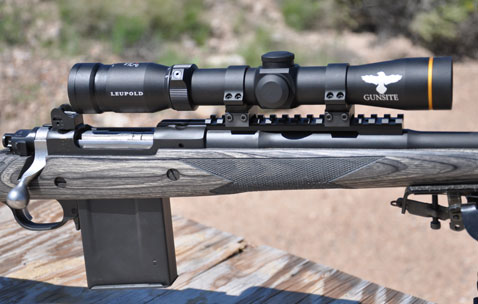
Scout scopes have come a long, long way in the thirty-something years since Cooper suggested them. Something he never envisioned, reliable, intermediate eye relief variable power scopes that can be mounted in the forward position, are now available. The one I mounted on the GSR 556 is terrific. Made by the Leupold Custom Shop it is a VX-R model with 1.5-5X variable power and a Firedot duplex reticle. The 30mm scope tube maximizes light to the eye and combined with the Firedot the scope is perfect for shooting in all conditions, especially low light – think hog hunting, or law enforcement. The Firedot is a red LED illuminated dot. You can leave it off and use the reticle in the conventional way or push a button on the left side scope turret and cycle the dot through several levels of brightness. The dot uses a trick motion sensor technology so it turns itself off if the rifle isn’t moved in 5 minutes, for example if you set it down, but comes back on when the rifle is picked up. What are the advantages to a variable power Scout scope? At the lowest power setting, and especially with the Firedot turned on, the scope works like a red dot sight. You can shoot with both eyes open, an advantage when dealing with multiple or moving targets or shooting at close range. If you need more power to help make a long range shot you simply dial it up. When shooting groups off the bench with the scope set at 5 power I found the field of view and brightness of the VX-R had me shooting with both eyes open, rather than the usual squint with one eye. The Leupold Custom Shop can build scopes with the reticle of your choice and can customize the scope with artwork or a logo applied to the scope body or the scope turret caps. Leupold decorated my scope with the Gunsite Raven.
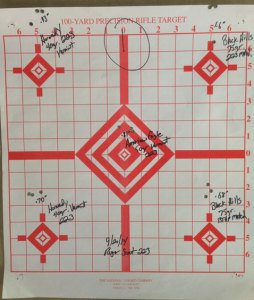 Since you’re probably interested in how the rifle shoots, let’s get to it. The chamber is designed to shoot 5.56 and .223 ammunition equally well and the barrel twist rate of 1:8 is meant to stabilize bullet weights from 40 to 77 grains. Through several range sessions I fired more than a dozen 5.56 and .223 factory loads and wasn’t able to detect any difference in accuracy between 5.56 and .223 ammunition. All bullet weights turned in good results and I can’t say that one was better than another. Although I didn’t chronograph all the loads I shot I did check the velocity of a sampling from each bullet weight and caliber. Comparing velocities I recorded to those published by the manufacturers (some of them put ballistic information on the ammo box, a practice I wish all would adopt) I found the velocity loss out of the short 16.1 inch barrel averaged somewhere around 150 feet per second (fps). The 40gr. Hornady varmint ammunition, clocked a velocity difference of about 300fps. During my accuracy testing I fired 3 shot groups off a bipod or over sandbags from a bench rest. With most of the ammunition I fired multiple groups and recorded the average group size. With a couple of examples the first group I fired was so good I figured I wasn’t likely to do any better and recorded that group. I did my shooting when temperatures were averaging in the 90s and I didn’t cool or clean the rifle, with each session running 200-300 rounds. Here are my results at 100 yards:
Since you’re probably interested in how the rifle shoots, let’s get to it. The chamber is designed to shoot 5.56 and .223 ammunition equally well and the barrel twist rate of 1:8 is meant to stabilize bullet weights from 40 to 77 grains. Through several range sessions I fired more than a dozen 5.56 and .223 factory loads and wasn’t able to detect any difference in accuracy between 5.56 and .223 ammunition. All bullet weights turned in good results and I can’t say that one was better than another. Although I didn’t chronograph all the loads I shot I did check the velocity of a sampling from each bullet weight and caliber. Comparing velocities I recorded to those published by the manufacturers (some of them put ballistic information on the ammo box, a practice I wish all would adopt) I found the velocity loss out of the short 16.1 inch barrel averaged somewhere around 150 feet per second (fps). The 40gr. Hornady varmint ammunition, clocked a velocity difference of about 300fps. During my accuracy testing I fired 3 shot groups off a bipod or over sandbags from a bench rest. With most of the ammunition I fired multiple groups and recorded the average group size. With a couple of examples the first group I fired was so good I figured I wasn’t likely to do any better and recorded that group. I did my shooting when temperatures were averaging in the 90s and I didn’t cool or clean the rifle, with each session running 200-300 rounds. Here are my results at 100 yards:
Hornady 55gr. GMX .223 1.49”
Hornady Superformance 55gr. .223 1.60”
Hornady V-MAX 55gr. .223 Varmint Express 1.49”
Winchester WCC 55gr. 5.56 2.00”
Hornady 75gr. BTHP .223 0.90”
Lake City 55gr. FMJ 5.56 1.01”
Black Hills 55gr. FMJ 1.39”
Hornady 55gr. V-MAX .223 1.06”
Federal 55gr. SP .223 0.69”
American Eagle 50gr. Tipped Varmint .223 0.81”
Black Hills 75gr. BTHP Match 0.68”
American Eagle 55gr. Tactical 5.56 2.57”
Gold Dot 64gr. GDSP .223 1.59”
Hornady 40gr. Varmint .223 0.82”
Remington 55gr. PSP 1.98”
Fired from a bench rest there is little to distinguish the GSR from other high quality centerfire rifles. Once you get it off the bench and into the field the differences become obvious. The smooth bolt action, quick handling and sighting system combine to make for fast and accurate first shot and follow-up hits. I like to use a shooting sling on a practical rifle and my favorite is the Rhodesian Sling made by Andy’s Leather. With it I can sling up and stabilize the rifle quickly and that aids my accuracy. As a matter of fact, some of the best groups I have fired with the GSR were fired from prone at 300 yards using Andy’s sling.
If you’re interested in a superb practical rifle the GSR 556 may be for you. Ruger now offers a choice between two popular calibers in the Gunsite Scout Rifle and I wouldn’t be surprised if more caliber choices are on the way.
For more information:
www.ruger.com
www.leupold.com
www.andysleather.com
www.gunsite.com
About the Author:
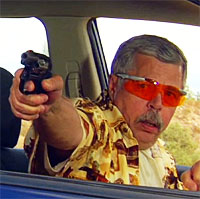 Ed Head is a regular on Shooting Gallery, Gun Stories and Down Range TV. He has worked for almost 30 years in law enforcement, first in the United States Air Force and then with the United States Border Patrol, retiring as a Field Operations Supervisor. During his Border Patrol career, Ed worked in a variety of patrol, investigative and training capacities. Ed has an extensive background as a firearms instructor, having trained thousands, ranging from beginners to police, military and special operations personnel. Having taught at Gunsite for 20 years, Ed first trained there under the world famous shooting school’s founder, Jeff Cooper, then later ran the school as the operations manager for more than five years. Ed lives in Chino Valley, Arizona, where he continues to teach and write.
Ed Head is a regular on Shooting Gallery, Gun Stories and Down Range TV. He has worked for almost 30 years in law enforcement, first in the United States Air Force and then with the United States Border Patrol, retiring as a Field Operations Supervisor. During his Border Patrol career, Ed worked in a variety of patrol, investigative and training capacities. Ed has an extensive background as a firearms instructor, having trained thousands, ranging from beginners to police, military and special operations personnel. Having taught at Gunsite for 20 years, Ed first trained there under the world famous shooting school’s founder, Jeff Cooper, then later ran the school as the operations manager for more than five years. Ed lives in Chino Valley, Arizona, where he continues to teach and write.

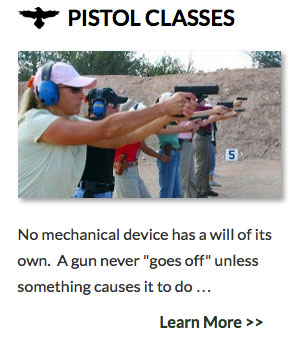

 MidwayUSA
MidwayUSA Ruger Firearms
Ruger Firearms SCCY Firearms
SCCY Firearms Streamlight
Streamlight Action Targets
Action Targets Gunsite Academy
Gunsite Academy
5 Responses to Reviewing the Ruger Gunsite Scout 5.56
You must be logged in to post a comment Login